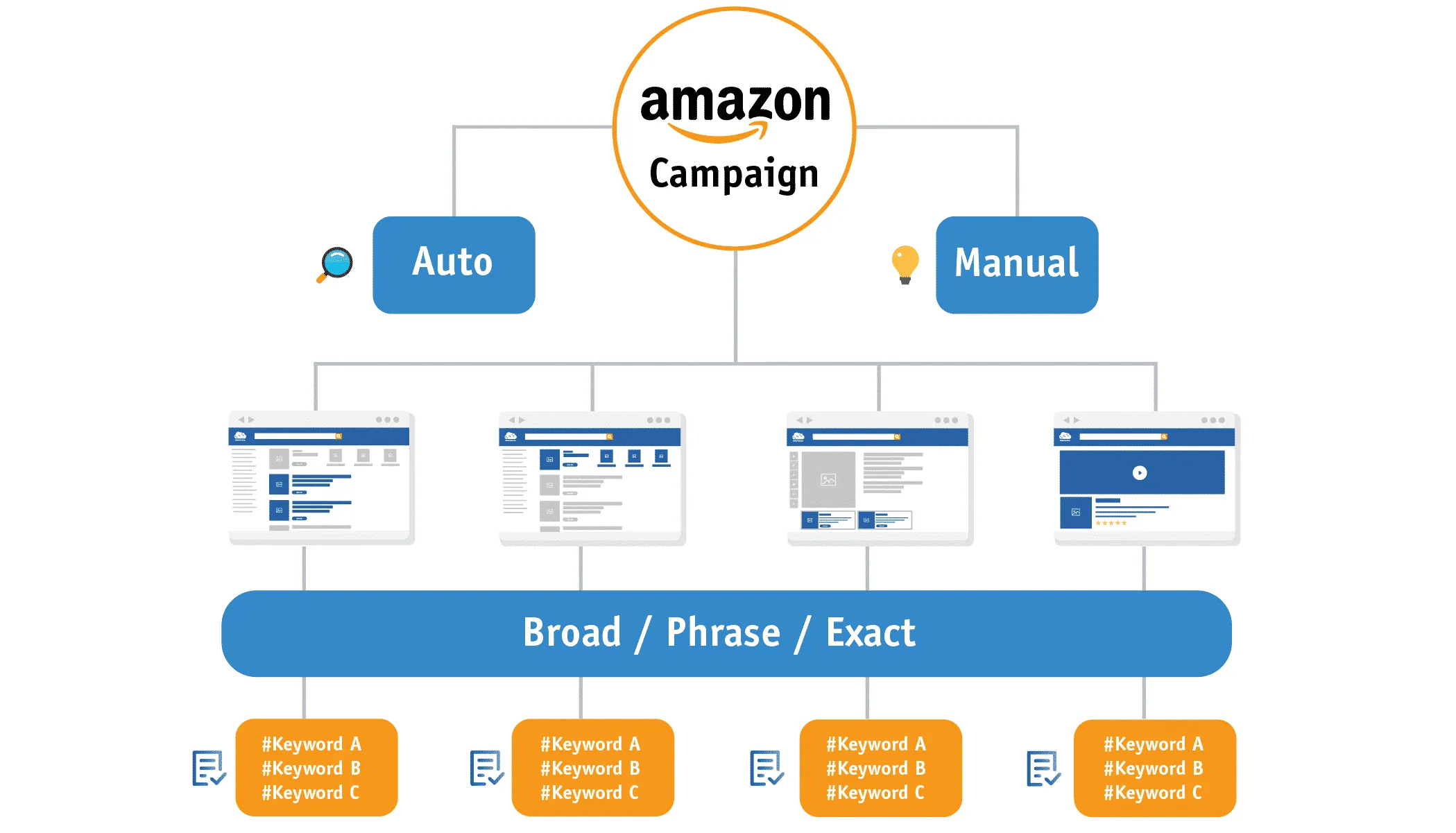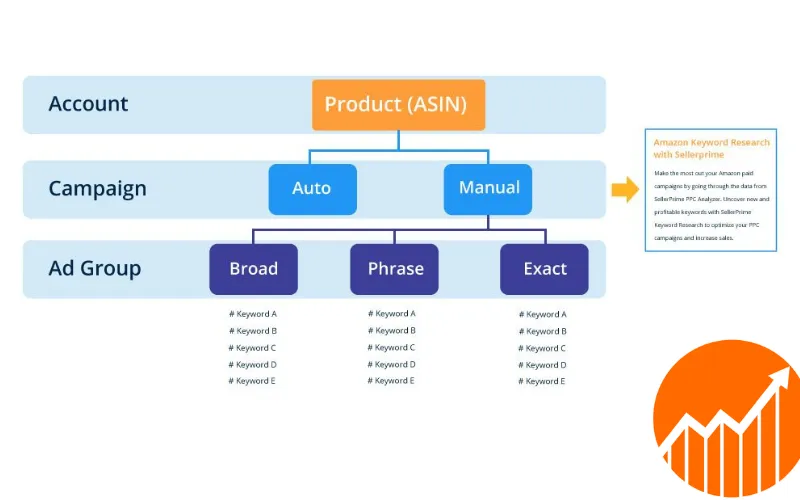Advanced Amazon PPC Campaign Structures: From Single Keyword Campaigns to Dynamic Bidding Strategies

Advanced Amazon PPC Campaign Structures: From Single Keyword Campaigns to Dynamic Bidding Strategies
Amazon Pay-Per-Click (PPC) advertising has become a cornerstone for sellers looking to increase visibility, drive traffic, and boost sales on the platform. With millions of products vying for attention, simply running basic campaigns is no longer enough.
To stay competitive, sellers must adopt advanced PPC strategies that allow for precise control, dynamic adaptation, and scalable success. This article delves into sophisticated Amazon PPC campaign structures, from Single Keyword Campaigns (SKCs) to dynamic bidding strategies, offering actionable insights for sellers ready to elevate their advertising game.
1. Understanding the Basics
Before diving into advanced tactics, it’s essential to understand the foundational elements of Amazon PPC.

Amazon PPC Campaign Types:
- Sponsored Products: These are the most common type of PPC ads, appearing in search results and product pages. They promote individual products and are ideal for driving conversions.
- Sponsored Brands: These ads showcase a brand logo, a custom headline, and multiple products. They are useful for building brand awareness and directing traffic to a storefront or product collection.
- Sponsored Display: These ads target audiences both on and off Amazon, leveraging Amazon’s vast data to retarget customers and reach new ones.
Keyword Match Types:
- Broad Match: Ads appear for searches that include misspellings, synonyms, related searches, and other variations.
- Phrase Match: Ads trigger when the search query includes the exact phrase or close variations.
- Exact Match: Ads show only when the search query matches the keyword exactly or with very close variants.
Automatic vs. Manual Campaigns:
- Automatic Campaigns allow Amazon to determine where to place your ads based on product information and are ideal for keyword discovery.
- Manual Campaigns give you full control over keywords and bids, making them suitable for targeted advertising.
2. Single Keyword Campaigns (SKC)
Definition and Purpose:
Single Keyword Campaigns (SKCs) are campaigns structured around a single keyword. This approach allows advertisers to exert precise control over bidding and budget allocation, making it easier to monitor performance and make data-driven decisions.
Benefits:
- Precise Control: By focusing on one keyword, you can adjust bids with surgical precision, optimizing for cost-effectiveness and performance.
- Budget Allocation: SKCs enable you to allocate budgets specifically to high-performing keywords, ensuring that your ad spend is directed where it’s most effective.
- Performance Tracking: With only one keyword in play, tracking and analyzing performance becomes straightforward, allowing for quicker optimization decisions.
Implementation:
- Selecting High-Converting Keywords: Start by identifying keywords with high conversion rates or those crucial to your product’s visibility.
- Setting Up SKCs: Create separate campaigns for each keyword, setting appropriate bids and budgets. Regularly monitor performance and adjust bids as needed.
- Monitoring and Adjusting Bids: Continually optimize bids based on performance metrics like ACoS (Advertising Cost of Sales) and conversion rate to maximize ROI.
3. Multi-Keyword Campaigns and Ad Groups

While SKCs provide granular control, Multi-Keyword Campaigns can be more efficient for managing larger groups of related keywords.
Campaign Structure:
- Grouping Keywords: Group keywords with similar themes or intents within the same campaign or ad group to streamline management and improve relevance.
- Advantages: Grouping keywords allows for more efficient budget management and can improve ad relevance by ensuring that similar keywords compete within the same budget and bid parameters.
Budget Distribution:
- Managing Budgets: Allocate budgets across multiple ad groups based on the performance and potential of the keywords within each group. Ensure that high-performing groups receive adequate funding to maximize returns.
Performance Analysis:
- Analyzing Keywords: Regularly review the performance of each keyword group. Look for patterns in ACoS, conversion rates, and click-through rates (CTR) to determine which groups to scale or optimize.
-
Scaling Successful Keywords: Identify high-performing keywords and allocate more budget to them, either within their current campaigns or by promoting them to SKCs for more focused attention.
- Dynamic Bidding Strategies
Amazon offers dynamic bidding options that automatically adjust your bids in real-time based on the likelihood of a sale. Understanding and utilizing these strategies can significantly enhance your campaign performance.
Overview of Dynamic Bidding:
- Dynamic Bidding Strategies
- Up & Down: Amazon increases your bid by up to 100% for placements that are more likely to convert and decreases it by up to 100% for less likely ones.
- Down Only: Amazon decreases your bid when a conversion is less likely, but never increases it.
- Fixed Bids: Your bid stays constant, regardless of the likelihood of a conversion.
Setting Up Dynamic Bidding:
- Choosing a Strategy: Use Up & Down for aggressive, conversion-focused campaigns where you’re willing to invest more in high-conversion opportunities. Down Only is more conservative, suitable for maintaining control over costs.
- Best Practices: Start with a balanced approach, using Up & Down for high-performing keywords or placements and Down Only for others. Regularly review performance and adjust strategies based on data.
Case Studies:
- Example 1: A brand using Up & Down bidding for a top-selling product saw a 20% increase in conversions, albeit with a slightly higher ACoS.
- Example 2: A seller using Down Only bidding for a lower-margin product maintained profitability while still achieving a significant increase in sales.
Adjusting Bids Based on Performance:
- Data-Driven Adjustments: Use performance data to refine your bidding strategy. For example, increase bids during peak shopping hours or for high-performing placements and decrease them during off-peak times or for lower-converting keywords.
5. Utilizing Placement Targeting
Placement targeting allows you to specify where your ads appear on Amazon, such as at the top of search results or on product detail pages. Leveraging this feature can significantly impact your campaign’s success.
Understanding Placement Targeting:
- Top of Search (First Page): Ads here receive the most visibility and often have higher conversion rates but come with increased costs.
- Product Pages: These placements are ideal for targeting customers who are comparing products.
- Rest of Search: Ads appear in lower positions, potentially offering cheaper clicks but with reduced visibility.
Optimizing for Different Placements:
- Dominate Specific Placements: If your product performs exceptionally well at the top of search, consider increasing your bid for that placement to maximize visibility and conversions.
- Budget Allocation: Allocate more budget to high-performing placements. Monitor the performance of each placement type and adjust your budget distribution accordingly.
Advanced Techniques:
- Combining Placement Targeting with Dynamic Bidding: Enhance your strategy by combining placement targeting with dynamic bidding. For instance, use Up & Down bidding for top-of-search placements to capitalize on high-conversion opportunities.
6. Automating and Scaling Your PPC Campaigns
As your campaigns grow, manual management becomes increasingly challenging. Automation tools and scaling strategies can help maintain performance while reducing the workload.
Automation Tools:
- Third-Party Tools: Tools like Helium 10, Jungle Scout, and Sellics offer features for automating bid adjustments, keyword discovery, and performance tracking.
- Amazon’s Native Tools: Amazon provides automation features like bulk operations and campaign rules that can simplify campaign management.
Rules-Based Automation:
- Setting Up Automated Rules: Create rules for bid adjustments based on performance metrics. For example, automatically increase bids on keywords with a high conversion rate or decrease them if ACoS exceeds a certain threshold.
Scaling Techniques:
- Expanding Campaigns: Gradually increase the budget for successful campaigns while maintaining close monitoring to ensure profitability.
- Managing Large-Scale Campaigns: As campaigns scale, use automation to maintain control. Implement a tiered approach where high-performing keywords receive more attention and resources.
7. Monitoring and Optimization
Continuous monitoring and optimization are key to long-term PPC success.
Key Metrics to Track:
- ACoS (Advertising Cost of Sales): The percentage of sales spent on advertising. Lowering ACoS can improve profitability.
- CTR (Click-Through Rate): Measures how often people click on your ad after seeing it. A higher CTR indicates more relevance.
- CPC (Cost Per Click): The amount you pay each time someone clicks on your ad. Lowering CPC while maintaining conversion rates can improve ROI.
- Conversion Rate: The percentage of clicks that result in a sale. Increasing conversion rates is critical for maximizing ad spend efficiency.
Regular Optimization Routines:
- Daily: Check for any dramatic changes in key metrics and make necessary adjustments.
- Weekly: Review performance by campaign, ad group, and keyword to identify trends and areas for improvement.
- Monthly: Conduct a comprehensive analysis of overall PPC performance, reallocating budgets and adjusting strategies as needed.
Troubleshooting Common Issues:
- Underperforming Campaigns: Identify the root cause, whether it’s poor keyword selection, low bids, or irrelevant ad copy, and make targeted adjustments.
- High ACoS: Reevaluate your bids, target keywords, and ad placements to ensure that your ads are both cost-effective and relevant.
Conclusion
This article has explored advanced Amazon PPC strategies that go beyond the basics, focusing on Single Keyword Campaigns (SKCs), dynamic bidding strategies, placement targeting, and the use of Latent Semantic Indexing (LSI) in PPC campaigns. We’ve seen how these strategies can be used to fine-tune campaigns, improve ROI, and scale effectively. The case studies demonstrated the real-world impact of these techniques, showing how precision, adaptability, and strategic targeting are essential for success.
Final Tips for Success
- Start Small, Scale Smart: Begin with precise, manageable campaigns like SKCs, and gradually scale them as you gain insights and see results.
- Leverage Data: Continuously monitor and analyze your PPC data. Use the insights to optimize your bids, keywords, and placements.
- Stay Flexible: Be ready to adapt your strategies based on real-time performance, especially with dynamic bidding and placement targeting.
- Test and Iterate: Regularly test different strategies, placements, and keywords to discover what works best for your products and target audience.
Future Trends in Amazon PPC
Looking ahead, we can expect Amazon’s advertising platform to continue evolving with more sophisticated AI-driven tools, enhanced automation options, and advanced targeting capabilities. As competition increases, personalization will become more crucial, with ads tailored to individual customer behaviors and preferences. Additionally, video ads and interactive formats are likely to play a more significant role in Amazon’s PPC ecosystem. Staying ahead of these trends will require continuous learning, experimentation, and adaptation.
